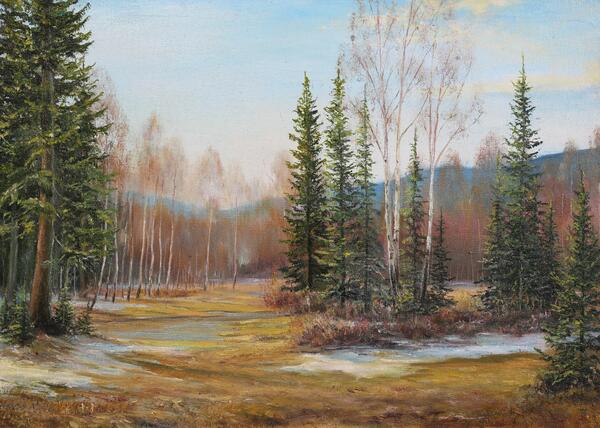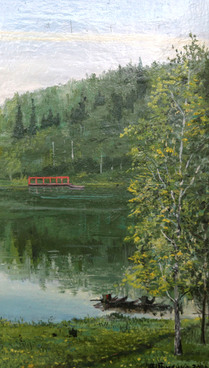Mikhail Yurievich Pavlenko is a skilled landscape painter Viewers find themselves strongly attracted to his paintings. The Siberian plains, the narrow river valleys at the foothills of the mountains, the deep lakes, the golden forests, the woodland paths and snow-covered meadows with thaw-holes in the spring — all these natural beauties are depicted with love in his art. Only someone full of a boundless love for the natural beauty of their native region can depict it in such a sunny, radiant way.
In The Last Snow the viewer sees a picturesque landscape in Mountain Shoria. In a birch and fir forest, surrounded by bluish mountains under an azure sky, April bringing dramatic changes. The painting’s composition emphasizes the mood of spring - there is a striking contrast between the dense fir trees in the middle ground and the branches of the deciduous trees which clearly signal the approaching renewal of nature. The slender birch trees are painted with a mass of fine brush strokes, giving the effect of a light mist. The trees
are depicted in a rhythmical and structured manner, with well-defined silhouettes alternating with thin and more ethereal forms. The effect is a painting that is full of life, which impresses the viewer with its sense of depth.
The use of contrasting tones in the composition gives this woodland scene volume and atmosphere. Every detail is tangible. It is hard not to be impressed by the painter’s skill in conveying so vividly the special charm and feeling of spring.
In Mountain Shoria the season of spring, which inspired the artist to paint The Last Snow, is slightly out of step with the calendar, arriving only in April. Spring here is particularly unpredictable: snowfalls can be followed by warm weather, and the warm spell interrupted by frosts or storms with torrential rain. But in Western Siberia the reawakening of the land after winter is one of Nature’s most beautiful phenomena — and Mikhail Pavlenko has captured this moment on canvas superbly.
The region depicted in this painting has long been inhabited by the Shorians, or Kuznetsk Tatars. In the past, the Shorian people considered that the year began with the arrival of spring. Chyl-Pazhi, the Shorian New Year, is traditionally celebrated at the time of the spring equinox. Literally, Chyl-Pazhi means “head of the year”. It was said that the first person to see the rays of the sun on the day of the spring equinox would enjoy a “double measure of happiness”.
The local people believed that in spring, when the snow begins to melt and the buds appear on the trees, the good spirits return to the earth after their long absence. At this time of year the shaman used to pray to the mountain spirit Tag-Eezi for the prosperity of his people.
In this painting Mikhail Pavlenko vividly conveys the solemnity of nature’s awakening from hibernation. The picture radiates a clear harmony, which the artist shares with the viewer.
In The Last Snow the viewer sees a picturesque landscape in Mountain Shoria. In a birch and fir forest, surrounded by bluish mountains under an azure sky, April bringing dramatic changes. The painting’s composition emphasizes the mood of spring - there is a striking contrast between the dense fir trees in the middle ground and the branches of the deciduous trees which clearly signal the approaching renewal of nature. The slender birch trees are painted with a mass of fine brush strokes, giving the effect of a light mist. The trees
are depicted in a rhythmical and structured manner, with well-defined silhouettes alternating with thin and more ethereal forms. The effect is a painting that is full of life, which impresses the viewer with its sense of depth.
The use of contrasting tones in the composition gives this woodland scene volume and atmosphere. Every detail is tangible. It is hard not to be impressed by the painter’s skill in conveying so vividly the special charm and feeling of spring.
In Mountain Shoria the season of spring, which inspired the artist to paint The Last Snow, is slightly out of step with the calendar, arriving only in April. Spring here is particularly unpredictable: snowfalls can be followed by warm weather, and the warm spell interrupted by frosts or storms with torrential rain. But in Western Siberia the reawakening of the land after winter is one of Nature’s most beautiful phenomena — and Mikhail Pavlenko has captured this moment on canvas superbly.
The region depicted in this painting has long been inhabited by the Shorians, or Kuznetsk Tatars. In the past, the Shorian people considered that the year began with the arrival of spring. Chyl-Pazhi, the Shorian New Year, is traditionally celebrated at the time of the spring equinox. Literally, Chyl-Pazhi means “head of the year”. It was said that the first person to see the rays of the sun on the day of the spring equinox would enjoy a “double measure of happiness”.
The local people believed that in spring, when the snow begins to melt and the buds appear on the trees, the good spirits return to the earth after their long absence. At this time of year the shaman used to pray to the mountain spirit Tag-Eezi for the prosperity of his people.
In this painting Mikhail Pavlenko vividly conveys the solemnity of nature’s awakening from hibernation. The picture radiates a clear harmony, which the artist shares with the viewer.




